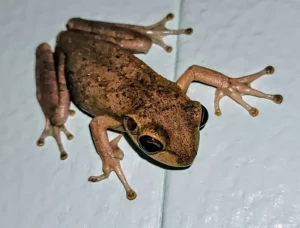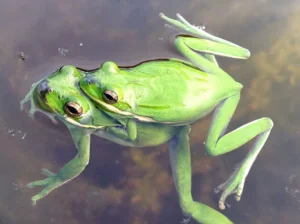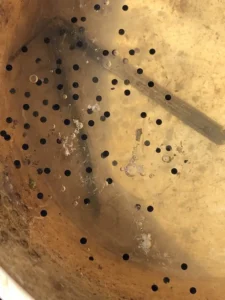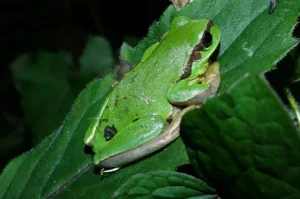The majority of tree frog species reproduce by laying eggs. These eggs are typically laid in the water and attached to submerged vegetation near the water surface – or on plants hanging over ponds.
Some tree frog species such as the common coqui (Eleutherodactylus coqui) lay their eggs on plants away from water and even in abandoned bird nests.
These eggs then hatch into young frogs that are morphologically similar to the adults. This is known as ‘direct development.’
Learning about tree frog eggs is great to add to your knowledge and feed your curiosity. Read on to find out everything you need to know about tree frog eggs including some really interesting facts, as well as how to easily identify them.
When Do Tree Frogs Lay Their Eggs?
The breeding season for frogs is largely stimulated by rainfall, higher temperatures, and the availability of food.
Tree frogs generally lay their eggs during the wetter months of the year.
In North America, most tree frogs will lay their eggs from January to early October, depending on the species, and latitude.
If the environmental conditions are conducive, some tree frog species may breed year-round.
For example, Cuban tree frogs (Osteopilus septentrionalis) in most of Florida breed predominately in the spring and summer months – but in the southern part of the state, they can breed year-round following heavy rains.

In general, the most suitable habitat for breeding for most tree frogs is a warm, humid area, with rain.
For Cuban tree frogs, optimal conditions are considered to be 81.5 °F (27.5 °C) with high humidity (97.8%) and rain.
Below is a table that shows approximately when 24 tree frog species lay their eggs:
Frog Species |
Scientific Name |
When They Lay Their Eggs |
| Gray tree frog | Hyla versicolor | Late April – early August |
| Cope’s gray tree frog | Hyla chrysoscelis | April – July |
| Spring peeper | Pseudacris crucifer | March – June in the north, and October -March in the south |
| American green tree frog | Hyla cinerea | March – September |
| Cuban tree frog | Osteopilus septentrionalis | May – October |
| Pacific tree frog | Pseudacris regilla | January – mid-May |
| Spotted chorus frog | Pseudacris clarkii | January – early June |
| Pine woods tree frog | Hyla femoralis | April – October |
| Barking tree frog | Hyla gratiosa | March – August |
| Squirrel tree frog | Hyla squirella | March – August |
| Australian green tree frog | Litoria caerulea | November – February |
| European tree frog | Hyla arborea | Late March – June |
| Blanchard’s cricket frog | Acris blanchardi | May – July |
| Southern cricket Frog | Acris gryllus | May – July |
| Northern cricket frog | Acris crepitans | May – August |
| Pine Barrens tree frog | Dryophytes andersonii | May – June |
| Canyon tree frog | Hyla arenicolor | April – July |
| Boreal chorus frog | Pseudacris maculata | May – early July |
| Bird-voiced tree frog | Hyla avivoca | April – August |
| Little grass frog | Pseudacris ocularis | January – September |
| New Jersey chorus frog | Pseudacris kalmi | March – May |
| Mediterranean tree frog | Hyla meridionalis | April – June |
| Italian tree frog | Hyla intermedia | March – June |
| Iberian tree frog | Hyla molleri | March – June |
See also: When Do Frogs Lay Their Eggs?
Where Do Tree Frogs Lay Their Eggs?
The majority of tree frogs lay their eggs in shallow, standing, or slow-moving freshwater bodies that are free of predatory fish.
This could be in fish-free ponds, spring-fed pools, flooded ditches, lake edges, river backwaters, bogs, marshes, swamps, and other wetlands, in deep tire tracks or potholes, puddles that collect in the holes of trees, or water-holding plants such as bromeliads.

Some tree frog species such as the American green tree frog (Hyla cinerea) occasionally lay their eggs in water bodies with fish.
A few species such as the Phantom tree frog (Ptychohyla dendrophasma) found in Guatemala – are even known to lay their eggs in fast-flowing streams, where they attach the eggs to the substrate.
Since these tree frogs lay their eggs in fast-flowing water, their tadpoles have very strong tails for swimming and mouths on the underside of their bodies. They use their large sucker-like mouth parts to cling onto rocks so they do not get washed away.
Other tree frog species such as the Red-eyed tree frog (Agalychnis callidryas) of Central and South America lay their eggs on the leaves of plants hanging over water – after the tadpoles hatch, they simply fall into the water.
A few tree frog species such as the gray foam-nest tree frog of southern Africa and the Fourlined tree frog of Southeast Asia lay their eggs in a foam “nest”.
This nest is built on branches or leaves overhanging a pond. When the tadpoles hatch, they will wriggle down the foamy secretion and plop into the water below.
Some tree frogs such as the Rio Grande chirping frog (Eleutherodactylus cystignathoides) are and the Red-eyed Coqui (Eleutherodactylus antillensis) known to lay their eggs in damp leaf litter or moist soil on land.
Below Is a Table That Shows Where 30 Tree Frog Species Will Lay Their Eggs In:
Tree Frog Species |
Scientific Name |
Where They Lay Their Eggs |
| Gray tree frog | Hyla versicolor | Shallow standing water |
| Cope’s gray tree frog | Hyla chrysoscelis | Shallow standing water |
| Spring peeper | Pseudacris crucifer | Shallow standing water |
| American green tree frog | Hyla cinerea | Shallow standing water |
| Cuban tree frog | Osteopilus septentrionalis | Shallow standing water |
| Pacific tree frog | Pseudacris regilla | Shallow standing water |
| Poison dart frog | Dendrobatidae | In moist leaf litter or on moist leaves |
| Glass frog | Centrolenidae | On leaves hanging over a stream |
| Red-eyed tree frog | Agalychnis callidryas | On leaves hanging over a pond |
| Amazon milk frog | Trachycephalus resinifictrix | In water-filled hollows in trees or bromeliads |
| Common Mexican tree frog | Smilisca baudinii | Shallow standing water |
| Pine woods tree frog | Hyla femoralis | Shallow standing water |
| Barking tree frog | Hyla gratiosa | Shallow standing water |
| Squirrel tree frog | Hyla squirella | Shallow standing water |
| Australian green tree frog | Litoria caerulea | Shallow standing water |
| European tree frog | Hyla arborea | Shallow standing water |
| Blanchard’s cricket frog | Acris blanchardi | Shallow standing water |
| Southern cricket Frog | Acris gryllus | Shallow standing water |
| Northern cricket frog | Acris crepitans | Shallow standing water |
| Pine Barrens tree frog | Dryophytes andersonii | Shallow standing water |
| Sierran tree frog | Pseudacris sierra | Shallow standing water |
| Boreal chorus frog | Pseudacris maculata | Shallow standing water |
| Bird-voiced tree frog | Hyla avivoca | Shallow standing water |
| Mountain chorus frog | Pseudacris brachyphona | Shallow staning water |
| Little grass frog | Shallow standing water | Shallow standing water |
| New Jersey chorus frog | Pseudacris kalmi | Shallow standing water |
| Common coquí | Eleutherodactylus coqui | On palm tree leaves and other plants away from water – or in abandoned bird nests |
| Red-eyed coqui | Eleutherodactylus antillensis | In damp leaf litter or moist soil on land |
| Rio Grande chirping frog | Eleutherodactylus cystignathoides | In moist soil on land |
| Gray foam-nest tree frog | Chiromantis xerampelina | In foam “nests” built on branches or leaves overhanging ponds |
See also: Where Do Frogs Lay Their Eggs?
How Do Tree Frogs Frogs Lay Their Eggs?
In most tree frog species, male frogs typically arrive at the breeding ponds before the females. Once they arrive, the males will begin to call for females.
When the females arrive, the males will try to grab them from behind in a tight mating embrace called ‘amplexus’.

Once in the amplexus embrace, the pair will swim around as the female chooses a site to lay her eggs.
The female deposits a single egg mass on a twig just below the water surface, and the male releases sperm into the water, to fertilize the egg mass as the female lays it.
How Many Eggs Do Tree Frogs Lay?
The number of eggs a tree frog lays can vary dramatically between different species.
Some tree frogs such as Glass frogs (Centrolenidae) of Central and South America only lay roughly 14 – 30 eggs eggs at a time, while others such as Barking tree frog can lay more than 3,000 eggs.
Below is a table that shows approximately how many eggs 30 tree frog species lay at a time:
Frog Species |
Scientific Name |
How Many Eggs They Lay (Approx.) |
| Gray tree frog | Hyla versicolor | 1000 – 2,000 |
| Cope’s gray tree frog | Hyla chrysoscelis | 1000 – 2,000 |
| Spring peeper | Pseudacris crucifer | 750 – 1,200 |
| American green tree frog | Hyla cinerea | 300 – 1,000 |
| Cuban tree frog | Osteopilus septentrionalis | 100 – 1,000 |
| Pacific tree frog | Pseudacris regilla | 400 – 750 |
| Poison dart frog | Dendrobatidae | 2 – 40 |
| Glass frog | Centrolenidae | 14 – 30 |
| Red-eyed tree frog | Agalychnis callidryas | 20 – 60 |
| Amazon milk frog | Trachycephalus resinifictrix | 300 – 2,500 |
| Common Mexican tree frog | Smilisca baudinii | 2,500 – 3,500 |
| Pine woods tree frog | Hyla femoralis | 800 – 2,000 |
| Barking tree frog | Hyla gratiosa | 1,500 – 4,000 |
| Squirrel tree frog | Hyla squirella | 900 – 1,200 |
| Australian green tree frog | Litoria caerulea | 200 – 2,000 |
| European tree frog | Hyla arborea | 200 – 2000 |
| Blanchard’s cricket frog | Acris blanchardi | 200 – 400 |
| Southern cricket Frog | Acris gryllus | 100 – 250 |
| Northern cricket frog | Acris crepitans | 200 – 400 |
| Pine Barrens tree frog | Dryophytes andersonii | 400 – 1,000 |
| Canyon tree frog | Hyla arenicolor | 100 – 400 |
| Boreal chorus frog | Pseudacris maculata | 150 – 1,500 |
| Bird-voiced tree frog | Hyla avivoca | 400 – 800 |
| Arizona tree frog | Hyla eximia | 508 – 1,476 |
| Little grass frog | Pseudacris ocularis | 100 – 200 |
| Coronated tree frog | Anotheca spinosa | 50 – 300 |
| New Jersey chorus frog | Pseudacris kalmi | 500 -1,500 |
| Mediterranean tree frog | Hyla meridionalis | 800 – 1,000 |
| Italian tree frog | Hyla intermedia | 400 – 1,000 |
| Iberian tree frog | Hyla molleri | 400 – 1,500 |
In some frogs such as the Cuban tree frogs, female fecundity increases (capability to produce offspring) as body size increases.
A large female Cuban tree frog can lay more than 15, 000 eggs in one breeding season. However, the eggs are laid 75 – 1000 at a time.
See also: How Many Eggs Do Frogs Lay?
What Do Tree Frog Eggs Looks Like?
In general, the eggs of most tree frogs that lay eggs in the water look just like those of other frogs.
They are laid in masses, small clusters, or singly – or in small clusters on leaves above water, and look like clear jelly-like globs, with a developing embryo visible inside each egg.
The embryos usually appear as small dots inside each egg – and when close to hatching well-developed tadpoles are visible inside each egg.





What Tree Frog Eggs Laid on Leaves Above the Water Look Like
Some tree frog species such as the red-eyed tree frog, and glass frogs do not lay their directly eggs in water.
Rather, they lay them on leaves that hang over the water.
When the eggs are ready to hatch, the tadpoles inside start wriggling around, breaking the eggs open.


What Tree Frog Eggs Laid in Foam Nests Look Like
Some tree frog species such as the gray foam-nest tree frog (Chiromantis xerampelina) of southern Africa and the Fourlined tree frog (Polypedates leucomystax) of Southeast Asia lay their eggs in a foam “nest”.
This nest is built on branches or leaves overhanging a pond.
During the mating process, the female frogs produce an oviduct secretion. This secretion is then whipped up by the female, and the attending male’s hind legs to create a froth in which the eggs are laid and fertilized.
The froth dries with a meringue-like crust to protect the eggs.
After a few days to a few weeks, depending on the species, the eggs will hatch and tiny tadpoles will wriggle down the foamy secretion and pop into the water below.

What Tree Frog Eggs Laid in Leaf Nests Look Like
Some tree frog species such as the waxy monkey tree frog (Phyllomedusa sauvagii), of South America, and other frogs in the Phyllomedusa genus – lay their eggs in leaf nests.
These leaf nests are constructed above forest pools of standing water by folding the margin of the leaves (sometimes, more than one leaf).
When the tadpoles, hatch they fall into the water, where they continue their development into adult frogs.

Do Tree Frogs Care For Their Eggs?
The majority of tree frog species do not show parental care for their eggs. After the mating is complete, both the males and females will leave the pond, abandoning the eggs.
This means the eggs are all on their own and are at the mercy of the environmental conditions. They are also easy meals for lots of predators.
That said, some tree frog species, such as the glass frogs, protect their eggs.
In many species, the females brood their eggs during the night the eggs are fertilized, and in almost a third of species, glass frog males remain with the newly laid eggs to defend them from predators until they hatch into tadpoles.

The male frog will also engage in hydric brooding, which is when the male will lay his body over the eggs to provide moisture and further protect the eggs from intruders like wasps.
Common coquis of Puerto Rico lay their eggs on plants away from water and even in abandoned bird nests.
Both males and females will fight off intruders from their nests by jumping, chasing, and sometimes biting.
The males are the primary caretakers of the eggs and provide moisture for the eggs by brooding them. This skin contact keeps the eggs moist – and during very dry periods, these frogs will leave and head to the water to gather more moisture for their eggs.
Common coquis have no tadpoles stage. Their eggs hatch into young fully developed froglets which are morphologically similar to the adults. This is known as ‘direct development.’
See also: Do Frogs Care For Their Young?
How Long Do Tree Frog Eggs Take To Hatch?
How long the eggs of a particular tree frog take to hatch can vary dramatically between species.
The eggs of some tree frogs such as the Cuban tree frog typically within 24- 48 hours, while the eggs of the Blanchard’s cricket frog take up to 3 weeks to hatch.
Below is a table that shows approximately how long the eggs of 30 tree frog species take to hatch
Frog Species |
Scientific Name |
How Long Their Eggs Take to Hatch (Days) |
| Gray tree frog | Hyla versicolor | 3 – 7 |
| Cope’s gray tree frog | Hyla chrysoscelis | 3 – 7 |
| Spring peeper | Pseudacris crucifer | 4 – 15 |
| American green tree frog | Hyla cinerea | 4 – 14 |
| Cuban tree frog | Osteopilus septentrionalis | 1 – 2 |
| Pacific tree frog | Pseudacris regilla | 14 – 35 |
| Poison dart frog | Dendrobatidae | 10 – 18 |
| Glass frog | Centrolenidae | 9 – 30 |
| Red-eyed tree frog | Agalychnis callidryas | 4 – 8 |
| Amazon milk frog | Trachycephalus resinifictrix | 1 – 2 |
| Common Mexican tree frog | Smilisca baudinii | 1 – 2 |
| Pine woods tree frog | Hyla femoralis | 1 – 3 |
| Barking tree frog | Hyla gratiosa | 5 – 10 |
| Squirrel tree frog | Hyla squirella | 1 – 2 |
| Australian green tree frog | Litoria caerulea | 1 – 2 |
| European tree frog | Hyla arborea | 10 – 14 |
| Blanchard’s cricket frog | Acris blanchardi | 6 – 21 |
| Southern cricket Frog | Acris gryllus | 4 – 6 |
| Northern cricket frog | Acris crepitans | 4 – 6 |
| Pine Barrens tree frog | Dryophytes andersonii | 3 – 4 |
| Sierran tree frog | Pseudacris sierra | 10 – 14 |
| Boreal chorus frog | Pseudacris maculata | 10 – 18 |
| Bird-voiced tree frog | Hyla avivoca | 3 – 4 |
| Mountain chorus frog | Pseudacris brachyphona | 6 – 10 |
| Little grass frog | Pseudacris ocularis | 1 – 2 |
| New Jersey chorus frog | Pseudacris kalmi | 1 – 2 |
| Mediterranean tree frog | Hyla meridionalis | 8 – 10 |
| Italian tree frog | Hyla intermedia | 10 – 14 |
| Iberian tree frog | Hyla molleri | 8 – 15 |
| Gray foam-nest tree frog | Chiromantis xerampelina | 4 – 6 |
See also: How Long Do Frog Eggs Take to Hatch?
What Do Tree Frog Tadpoles Look Like?
Generally, tree frog tadpoles look just like the tadpoles of other frog species.
When first hatched, tadpoles tadpoles have visible external gills, often in pairs, on either side of their heads. They use these gills to breathe in the water, just like fish.
They have no limbs and swim through water via undulating movements of a long boneless tail fin. Like fish, tadpoles have a lateral line organ, which runs along each side of their body and tail, through which they sense movements in water.
When tadpoles reach the midway point of their development, opercular folds grow backward from the hyoid arch of each side covering the external gills and gill slits.
In this way, a gill cover known as an “operculum” is formed enclosing the external gills and gill slits – turning the external gills into internal gills. These internal gills are vented by ventrolateral openings, known as spiracles.
Depending on the species, there can be:
- Two spiracles on both sides of the body,
- A single spiracle on the underside near the vent, or
- A single spiracle on the left side of the body
Spiracles are tubular structures leading out of the opercular chamber. Tadpoles eject water through the nostrils and through the spiracles.
Tadpoles primarily feed on algae and detritus in their early stages. Due to this mostly herbivorous diet, both frog and toad tadpoles have very long tightly coiled intestines, that make up more than half of their body mass.
The intestine takes up about half the space within the tadpole’s body and can be more than ten times longer than the tadpole itself.

It is also its largest organ and is visible through the translucent belly skin in many tadpole species.
Here is what the tadpoles of a few tree frog species look like:




Do Tree Frogs Care For Their Tadpoles?
Generally, tree frogs do not attend to their tadpoles or care for them in any way. In the tree frog species that show parental care, the care is to protect the eggs before they hatch.
Once the tadpoles hatch from their eggs, the parents leave and the tadpoles fend for themselves.
However, a few tree frog species such as the Jerdon’s tree frogs(Nasutixalus jerdonii) found in northeastern India show parental care for their tadpoles.

These frogs lay their eggs on the insides of tree hollows, which hold pools of water.
These hollows don’t contain enough food for developing tadpoles, so the females lay unfertilized eggs for their tadpoles to eat until they turn into froglets.
This is called “oophagy” and is one of the adaptations that many amphibians have developed to survive in harsh environments.
What Animals Prey on Tree Frog Eggs & Tadpoles?
Tree frogs often lay eggs in open ponds and other water bodies – where predators accumulate over the course of the breeding season.
A large number of tree frog eggs are eaten by newts, turtles, leeches, dragonfly larvae, diving beetles, and other large water bugs.
(image of an eastern newt eating wood frog eggs)
It’s common for over 75% of frog eggs in a pond to be wiped out by predators before they hatch.
When the tadpoles, they too will typically have low survival rates.
Many tadpoles often hatch into crowded pools, and there will be intense competition for food and limited resources, meaning again the number of tadpoles will naturally thin out.
Many tadpoles are also preyed on by various aquatic insects (diving beetle adults & larvae, giant water bugs, etc.) as well as northern water snakes, ribbon snakes, turtles, and various wading birds.
What to Do if You Find Tree Frog Eggs
If you live near a wooded area, especially near a pond, or another water body there’s a chance of encountering frog eggs in the spring. If this happens, be sure to avoid disturbing the eggs.
Disturbing or removing the eggs from the water could damage them, or even kill the tiny embryos developing inside the eggs.
If you find frog eggs out of the water, it is best to leave them alone, especially if they are very near the water.
However, if you find frog eggs that were disturbed (by a human or animal) and taken out of the water, you could try to put them back in the water.
If the egg mass is still attached to a stick, very gently put the stick back in the water (just a few inches below the surface).
Still, the eggs are not guaranteed to hatch because the disturbance may have damaged them or killed the embryos developing inside.
Of course, there’s no harm in observing frog eggs from a distance.
Featured image credit: Jake Kirkland (CC BY-NC-SA 4.0 DEED)
Sources:
Lannoo, Michael J. (2005). Amphibian declines: the conservation status of United States species. Berkeley and Los Angeles, California: University of California Press.
Vági, B., Végvári, Z., Liker, A., Freckleton, R. P., Székely, T. (2019). Parental Care and The Evolution Of Terrestriality In Frogs. Proc. R. Soc. B., 1900(286), 20182737. https://doi.org/10.1098/rspb.2018.2737
Ana L. Salgado, Juan M. Guayasamin “Parental Care and Reproductive Behavior of the Minute Dappled Glassfrog (Centrolenidae: Centrolene peristictum),” South American Journal of Herpetology, 13(3), 211-219, (30 September 2018)
Agar, W.E. (1909), The Nesting Habits of the Tree-Frog Phyllomedusa sauragii. Proceedings of the Zoological Society of London, 79: 893-897. https://doi.org/10.1111/j.1469-7998.1910.tb06980.x
Gould, John & Valdez, Jose & Clulow, John & Clulow, Simon. (2021). Left High and Dry: Froth Nesting Allows Eggs of the Anuran Amphibian to Complete Embryogenesis in the Absence of Free-Standing Water. Ichthyology & Herpetology. 109. 537-544. 10.1643/h2020142.

